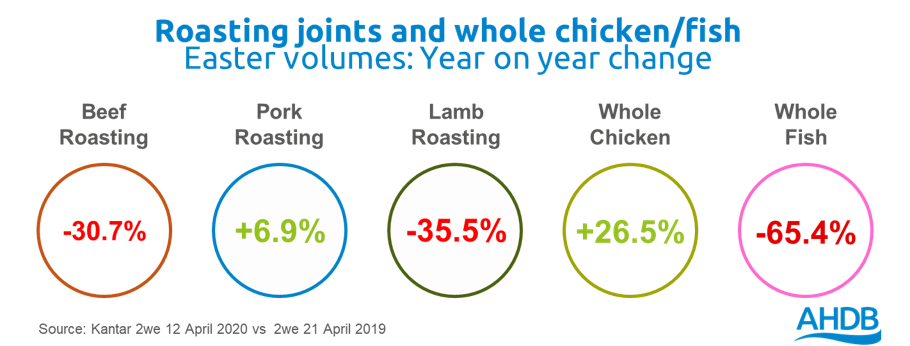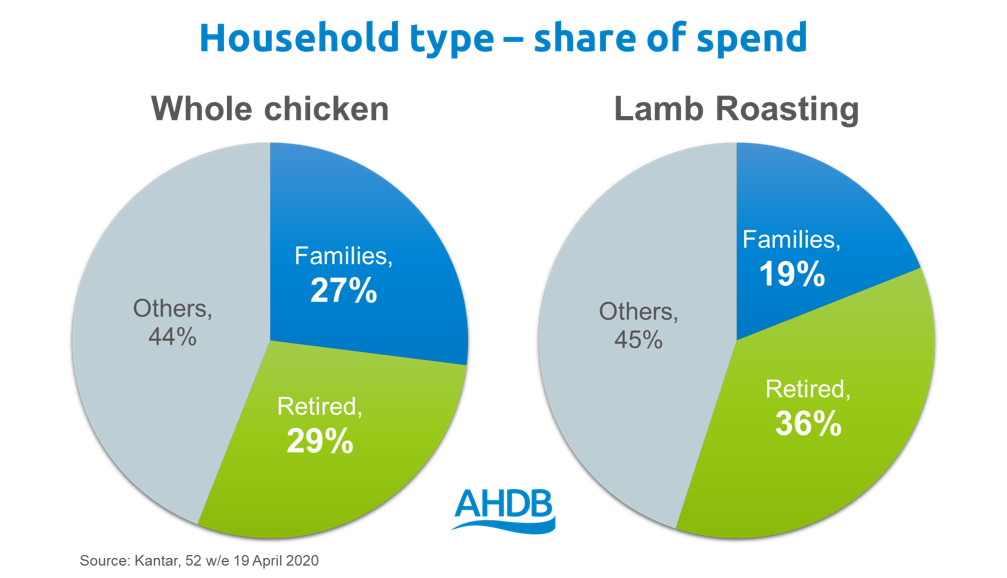Coronavirus lockdown has a big impact on lamb sales this Easter
Thursday, 21 May 2020
With the coronavirus crisis at its peak and UK in lockdown, it was no ordinary Easter this year. A perfect storm of fewer social gatherings, older consumers in isolation and a change to where we shop have combined to impact key Easter categories, including lamb.
The loss of the usual Easter occasion
Easter is a key time of the year when people gather with family and friends for a meal. In 2019, 47% of Easter occasions had three or more people present, 10 percentage points higher than the average occasion (Kantar Usage). Being under lockdown created a barrier for families that would normally travel to gather. Therefore, instead over 40% said they would be staying in touch with friends and family virtually.
This affected all key Easter categories – data from Kantar shows that Easter eggs, hot cross buns and chocolate gifting all experienced double-digit decline, along with lamb. This Easter, 27% of lamb volume was lost, equating to 2,100 tonnes. Over 80% of losses were driven by lamb leg roasting joints and there is an indication that non-British products were most negatively impacted.
The seasonal uplift versus the rest of the year was still there for the Easter categories, it just wasn’t as high as usual. In the two weeks leading up to Easter, lamb roasting still achieved a £19.3m uplift versus the average 2 weeks across the year, but was down £12.1m when compared to the 2019 uplift. This means that Easter accounted for only 11% of annual sales, compared to 16% a year ago. The category will therefore need to recoup some losses later in the year.
As Easter was a more modest occasion this year, products like chicken breasts, beef mince and pork sausages all did well, fitting into everyday meals. While days around Easter 2019 were hot and sunny, 2020 experienced the sunniest April on record and so this is also likely to have swayed shoppers to barbecue-friendly products like sausages. Smaller cuts of lamb like chops, steak and mince did perform well this Easter and as lockdown continues, emphasis should be placed on these cuts that suit smaller social occasions.
Versatility was also key for other categories that would normally be paired with lamb at Easter. Potatoes are the number one item found in the same basket as lamb leg but, despite the losses for lamb, fresh potatoes were still in volume growth of +8.2%.
There were mixed outcomes for the roast meats, with lamb, beef and whole fish negatively impacted. Pork roasting was supported by an increase in shoulder and loin, however, declines for leg offset some of this uplift.

Older shoppers social distancing
Retired shoppers were most impacted by social distancing and the impact of this was evident across the Easter categories.
Lamb, particularly roasting joints, are heavily reliant on shoppers over 65. Whole chicken, on the other hand, appeals more to families.

With people not able to plan for the Easter occasion, whole chicken seemingly took the place of lamb leg, as the broader household appeal means it is a crowd pleaser than can fulfil numerous occasions
While the situation surrounding Easter cannot be controlled, there is clearly a need to excite a younger demographic so lamb can continue for a number of years.
Main stores being used less often
Since lockdown set in, people have been visiting the supermarkets less frequently and have instead increased their usage of the online and convenience channels. Butchers have also been used by more people, with 56,000 more shoppers buying something from a butcher’s shop this Easter.
The reduction in the use of main stores had a big effect on the overall household penetration of meat, fish and poultry. These stores are the ones in which people tend to pick up roasting joints, so the movement to convenience stores clearly has a big impact on sales of red meat roasting. It’s important that beef, lamb and pork are stocked in the right formats in convenience stores, particularly during seasonal events where shoppers may still want their usual cuts, despite not being able to visit their usual store.
While the range in convenience stores will usually be price-led smaller cuts, there is still opportunity for red meat roasting through the online channel. During the Easter period, lamb leg maintained its share of online sales and so presence of roasting joints in banners and recipe inspiration my help attract shoppers.
Conclusion
While Easter is still a very valuable occasion, the loss of our usual Easter gatherings created a bit of a lacklustre time for the MFP category, particularly lamb. People will hopefully be able to gather again next year, and a cultural shift means that spending these occasions with family have become more valuable than ever. While we have no control over lockdown or the weather during Easter, there is still a case for the lamb sector reducing its reliance on older consumers and reaching out to a younger demographic in order to create opportunities for future growth.

